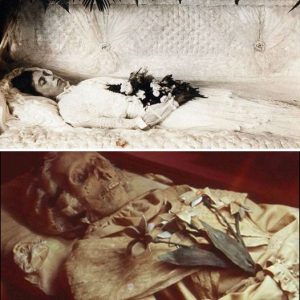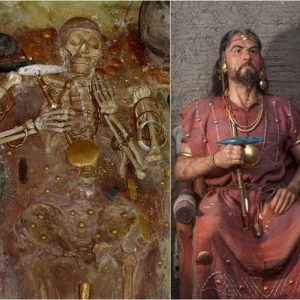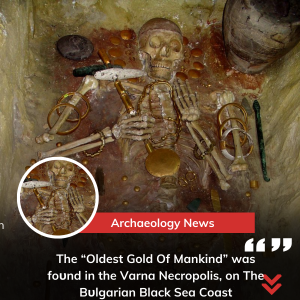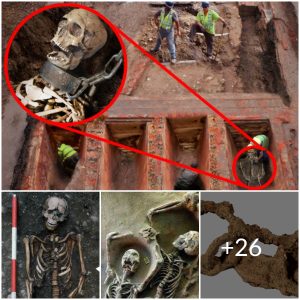Ever since mummy KV55 was discovered in 1907, it has generated deep interest, debate, and controversy. The big issues have been identifying the KV55 mummy in ancient Egyptian history and combining its most probable identity with that person’s proposed age of death.
Could mummy KV55 really be the ‘heretic pharaoh’ Akhenaten, as many scholars believe? If so, a team of scientists at the Forensic Anthropology, Paleopathology and Bioarchaeology (FAPAB) Research Center in Sicily, Italy, have finally revealed the image of this famous pharaoh – and it’s nothing like how he was portrayed in the ancient artwork!

Statue of Akhenaton in the Louvre. (FAPAB Research Center)
Facts and Controversy Surrounding Mummy KV55
The mummy was found with grave goods attributed to different people and a desecrated coffin in the undecorated tomb KV55 in the Valley of the Kings in 1907 by an Egyptologist named Edward R. Ayrton.
This tomb is just a few meters from Tutankhamun’s tomb.
Upon excavation, mummy KV55 disintegrated into dust and bones, so today it’s only a skeleton.
It was first suggested to be Queen Tyje (due to a broad pelvis), but Australian scientist Grafton E. Smith later declared the remains are male.
Mummy KV55’s genetic results show this is the genetic father of Tutankhamun, however palaeomolecular experts criticized some of the results in 2010.
Historical and archaeological research, including some artifacts in the tomb, suggest that mummy KV55 is Akhenaton (Akhenaten).
Akhenaten (r. 1353–36/35 BC) is known as the ‘heretic pharaoh’ because he developed monotheism, worshipping the one ‘true’ god of Aten (the Sun disk). He was the son of Amenhotep III and the father of Tutankhamun.
Historical evidence, which is fragmented and conflicting, suggests that Akhenaten died when he was about 40 years old.
However mummy KV55 belongs to a man who is believed to have died in his early 20s.
Some scholars argue that mummy KV55’s age of death demonstrate that this is actually an enigmatic Late Amarna period person named Smenkhkare.
An Exclusive Interview with Dr. Michael E. Habicht
FAPAB Director Francesco M. Galassi, a physician and palaeopathologist, and Egyptological studies coordinator Michael E. Habicht oversaw the creation of the new facial reconstruction of the KV55 mummy, which was completed by the well-known Brazilian expert Cicero Moraes, who has been recognized for his skilled facial reconstructions.
Dr. Michael E. Habicht, who is also an Archaeologist, Egyptologist, and Senior Research Fellow at Flinders University, Australia, told us about the new facial reconstruction and the research team’s perspectives on the mysteries surrounding mummy KV55.
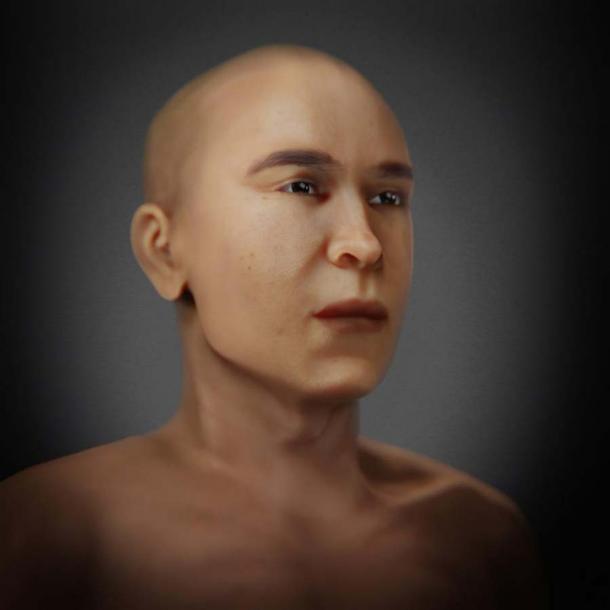
Side view of the facial reconstruction of Mummy KV55. (FAPAB Research Center)
Interview
Alicia McDermott: Please describe the process used to create this facial reconstruction.
Dr. Michael E. Habicht: Based on published data and images from various studies, a three-dimensional skull model of KV 55 was created. This was then checked again against the images.

Mummy KV55’s skull with data points used in the facial reconstruction. (FAPAB Research Center)
Facial muscles, eyes, fat pads and skin are now modelled on this digital skull model using the so-called Manchester method. The tissue thickness is determined for numerous anatomical points based on forensic mean values.
The skin, eyes and shape of the ears are approximations based on the fact that this is an Egyptian, which accounts for brown eyes and a skin complexion that is still common in Egypt today.
AM: How does this facial reconstruction balance forensic art with anatomical and anthropological information?
MH: The facial reconstruction was blindfolded: Cicero Moraes, our expert for face reconstruction, only received the skull data and the information that it was a man from Egypt, and not older than 25 years. Therefore, this reconstruction has no Egyptian crowns or royal jewelry to distort the impression. Therefore, we think that our reconstruction is as objective as possible and follows purely scientific methods.
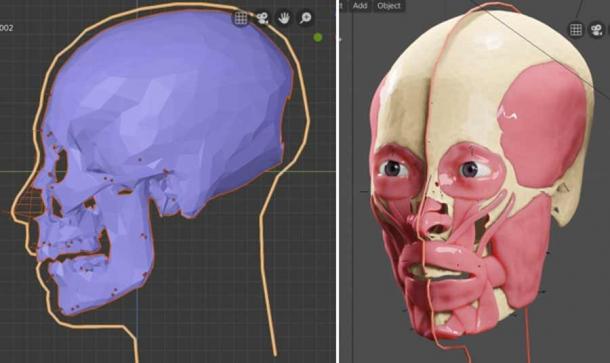
Steps in the facial reconstruction process. (FAPAB Research Center)
AM: There is a lot of controversy surrounding the skin color of ancient Egyptians, could you please tell us how you made the choice of skin color for this reconstruction?
MH: It is indeed a highly debated topic but it should be assessed with an open mind, pushing away the racist connotations that have characterized this debate in the past. We decided to use skin tone IV (in the Fitzpatrick scale of I-VI) which is typically encountered in Egypt and in the Mediterranean, an olive completion. Based on the available evidence it would be unrealistic to opt for a much lighter or much darker skin tone. Eventually, a new genetic analysis of KV55’s remains would add more evidence.
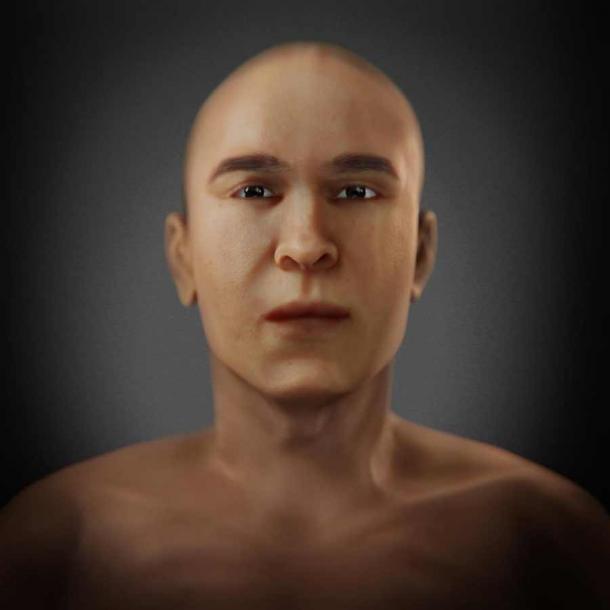
The facial reconstruction of mummy KV55. (FAPAB Research Center)
AM: Why has it been so difficult to pinpoint an age of death for this mummy?
MH: It wasn’t particularly difficult, to be honest, as the comprehensive study by the late anthropologist Eugen Strouhal demonstrated. It required an objective evaluation using all available skeletal districts and a consultation of the recent anthropological literature.
The main problem was the a priori identification with Akhenaton plus the assumed age at death of the heretic pharaoh (about 30 years old or older). This has represented the main problem, but by objectively assessing the skeleton and published literature it appears clear that it belongs to a younger individual between the end of adolescence and early adulthood, 19-22 years).
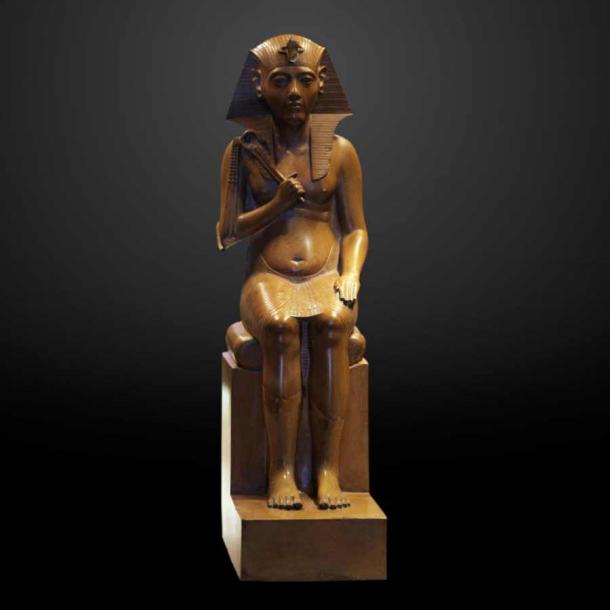
The heretic pharaoh Akhenaten. (FAPAB Research Center)
AM: With so much controversy surrounding the mummy’s identification, who do you think is the best candidate? Is it Tutankhamun’s father Akhenaten? If so, how does that information fit with the belief that his death occurred when he was around 40 years of age and this mummy being younger? Or could the mummy be the remains of the enigmatic figure called Smenkhkare, as some scholars have proposed?
MH: It is most reasonable to assume that Akhenaton and Nefertiti are the historical parents of Tutankhamun, due to historic inscriptions. If one accepts the genetic study from 2010, KV 55 shall be the father and the younger lady KV 35 is the genetic mother of Tutankhamun.
Historical records testify 17 years of reign by Akhenaton. It is debated if some of the first years might be a co-regency with his father Amenhotep III. We acknowledge that an age of 22 years and 17 years of reign would make Akhenaton very young at the time of accession.
It would hardly be arguable that Akhenaten could be the real father of the eldest daughters (Meritaton, Maketaton and possibly also Anchesenamun). The mummies of these daughters have not yet been identified, so Amenhotep III could also be the father (contrary to inscriptional propaganda). Since Tutankhamun was only born in the 12th year of Akhenaten, it is still possible that Akhenaten was the real father, even if he was very young.
If Smenkhkare is assumed to be the father of Tutankhamun, this is also problematic. There is no certain historical evidence that Smenkhkare was a younger brother of Akhenaten.
Moreover, many experts argue that Smenkhkare is in fact the fictitious figure that Queen Nefertiti assumed at the end of Akhenaten’s reign to succeed him as male king (analogous to Hatshepsut, who ruled as King Maat-Ka-Ra).
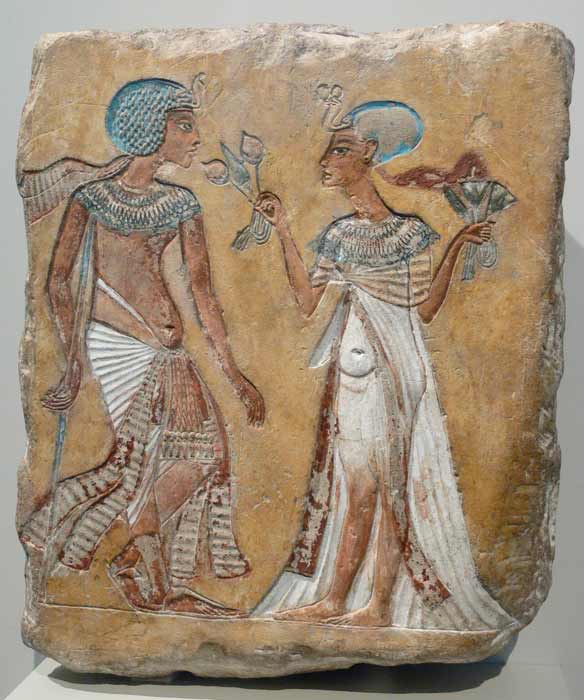
A relief of a royal couple in the Amarna style; figures have variously been attributed as Akhenaten and Nefertiti, Smenkhkare and Meritaten, or Tutankhamen and Ankhesenamun. (Public Domain)
AM: If this is Akhenaton, why does he look so different from the ancient representations of the ‘heretic pharaoh?’ Could it be due to the style of art that was used by artists in the Amarna period?
MH: Egyptian art is generally not very realistic, but reflects a desired ideal image, especially in the case of the king. In the Amarna period, a grotesque, almost comic-like sense of art was introduced. In the course of time, art became more moderate and elegant again (the famous Berlin bust of Nefertiti is in this later tradition). It is therefore not surprising that the family members of the royal family of Amarna look normal and not like in Amarna art.
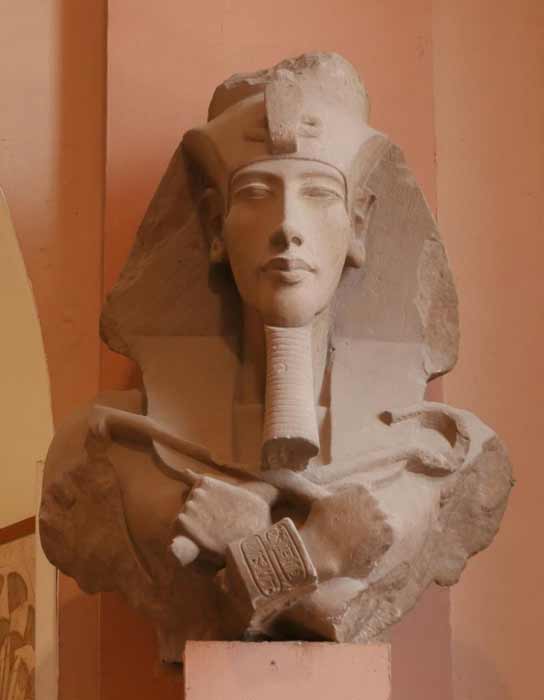
Broken colossal statue of Akhenaten in the Amarna art style. (FAPAB Research Center)
The research team is currently finishing work on a full-length anthropological report of their study of mummy KV55 and their facial reconstruction. It will be published in a peer-reviewed international journal.
